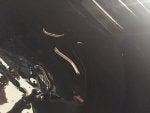So, I decided to try out Mobil 1's "Annual Protection" formula in the QP. I generally change my oil every 2K-3K miles or so, so my intentions were not to put the oil's longevity claims to test. I did want to see if the formula that allows the company to make that claim would lend something in terms of lubrication, variator noise reduction or the like. The oil, by the way, is the most expensive on the market - double that of standard Mobil 1 EP Synthetic.
Well on my first test drive, I noticed that I had a rattle on acceleration that I've never heard before. It only starts when accelerating hard and I can only hear it in the cabin. By lunch time it got worse and the car threw the code P0010 - timing error on bank 1. My immediate thoughts were the bulk modulus of the oil wasn't strong enough to keep the solenoid on bank 1 in check, so I wanted to start by first changing out of that oil. The viscosity was lower than what I typically use (5w30) however I have used 5w30 EP with no issues in the past.
I purchased new oil at lunch and decided to change it yesterday afternoon - that is when I was shocked!
After draining the oil, I noticed pieces of a tan rubber - just like worms that had drained out with the oil. I picked them up and they had the same consistency, tan color and diameter as a chewed up rubber band. My first thought was that an internal gasket had given way somewhere in the top end and it drained out with the oil, possible accelerated by the recent oil change. But, after stretching the rubber with my fingers and placing a call to FM Orlando, who wholesales and sells more parts than any other dealership due to their proximity to the distributing center, they informed me that there is NOTHING IN THE ENGINE THAT RESEMBLES THE PIECES. It is indeed a rubber band.
So it turns out that the rubber band must have fallen into the oil at some point during manufacturing or pouring at Mobil 1. I did fill the sump using a 5-quart jug against a light red funnel, so spotting it would've been very difficult if not impossible.
Since I changed the oil to Valvoline last night, the code disappeared but the acceleration rattle still appears after the car is fully warmed up after about 15 min of driving. It is very possible that the rubber band could have traveled into bank 1 and slowed things down enough to trigger the camshaft position sensor to detect a fault. The rattle DOES NOT sound like a variator rattle - it sounds like a "ping," like the one you get when you use 87 octane in a high compression vehicle.
Just to confirm this is in fact a rubber band, I ask any of you if you recognize a light tan, thin rubber part that resembles a rubber band anywhere internally. I will post pictures shortly. Just keep in mind that it is heavily chewed up however it is very stretchy, just like a rubber band - unlike a typical gasket.
Any help is appreciated.
Erik
Well on my first test drive, I noticed that I had a rattle on acceleration that I've never heard before. It only starts when accelerating hard and I can only hear it in the cabin. By lunch time it got worse and the car threw the code P0010 - timing error on bank 1. My immediate thoughts were the bulk modulus of the oil wasn't strong enough to keep the solenoid on bank 1 in check, so I wanted to start by first changing out of that oil. The viscosity was lower than what I typically use (5w30) however I have used 5w30 EP with no issues in the past.
I purchased new oil at lunch and decided to change it yesterday afternoon - that is when I was shocked!
After draining the oil, I noticed pieces of a tan rubber - just like worms that had drained out with the oil. I picked them up and they had the same consistency, tan color and diameter as a chewed up rubber band. My first thought was that an internal gasket had given way somewhere in the top end and it drained out with the oil, possible accelerated by the recent oil change. But, after stretching the rubber with my fingers and placing a call to FM Orlando, who wholesales and sells more parts than any other dealership due to their proximity to the distributing center, they informed me that there is NOTHING IN THE ENGINE THAT RESEMBLES THE PIECES. It is indeed a rubber band.
So it turns out that the rubber band must have fallen into the oil at some point during manufacturing or pouring at Mobil 1. I did fill the sump using a 5-quart jug against a light red funnel, so spotting it would've been very difficult if not impossible.
Since I changed the oil to Valvoline last night, the code disappeared but the acceleration rattle still appears after the car is fully warmed up after about 15 min of driving. It is very possible that the rubber band could have traveled into bank 1 and slowed things down enough to trigger the camshaft position sensor to detect a fault. The rattle DOES NOT sound like a variator rattle - it sounds like a "ping," like the one you get when you use 87 octane in a high compression vehicle.
Just to confirm this is in fact a rubber band, I ask any of you if you recognize a light tan, thin rubber part that resembles a rubber band anywhere internally. I will post pictures shortly. Just keep in mind that it is heavily chewed up however it is very stretchy, just like a rubber band - unlike a typical gasket.
Any help is appreciated.
Erik







